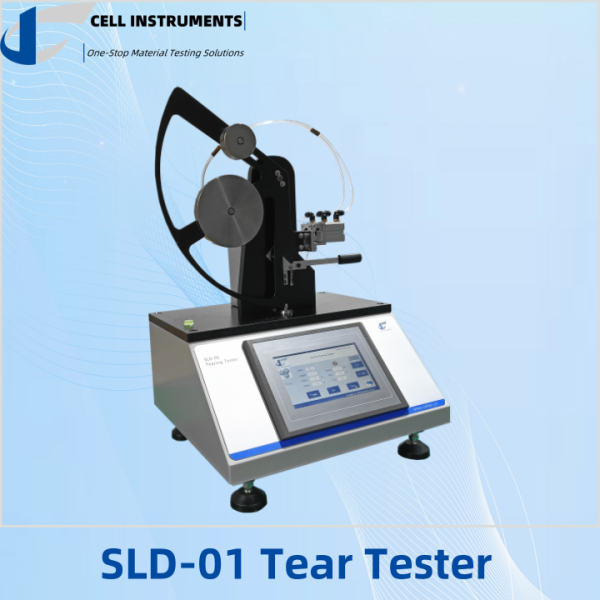SLD-01 Tear Tester
- Standard: ASTM D1922, ASTM D1424, ASTM D689, ISO 6383, ISO 1974
- Manufacturer: Cell Instruments
- Applications: Packaging materials, medical device materials, pharmaceutical testing, adhesives, textiles, paper and cardboard containers, and more.
- Customization: Available for special testing requirements and automation transformations
I. Introduction of Elmendorf Tear Strength Tester
The Elmendorf Tear Strength Tester is a specialized instrument designed to measure the tear resistance of various materials, including paper, textiles, and plastic films. Utilizing a pendulum mechanism, it quantifies the force required to propagate a tear through a material sample, providing crucial data for quality control and product development.
1. Importance and Applications in Various Industries
The Elmendorf Tear Strength Tester plays a vital role in multiple industries by ensuring the durability and reliability of materials. Its applications span across packaging, textiles, medical devices, pharmaceutical packaging, adhesives, sealants, and paper and cardboard containers. Accurate tear strength measurement is essential for manufacturers to meet industry standards and deliver high-quality products to consumers.
2. Key Features
- PLC Control and HMI Touch Screen: The industrial-level programmable logic controller (PLC) and Human-Machine Interface (HMI) touch screen ensure precision and ease of use.
- Standard Conformance: All components and parts strictly adhere to industry standards, ensuring consistency and reliability in testing.
- Calibration Capability: The tester includes weights for checking and calibrating different test ranges.
- Paper-Focused Features: For users working with paper materials, the option to add units of millinewtons (mN) and tear index parameters is available.
- Wide Test Range: The tester offers a broad test range, accommodating various materials.
- Pneumatic Specimen Clamping: Ensuring secure and consistent gripping of the test material, which is essential for accurate and repeatable results.
- Pendulum Automatic Release: Simplifies the testing process and ensures consistent test execution.
- Data Auto Statistics: Automatically collects test data and stores test results.
- Microprinter: The built-in microprinter allows for immediate printing of test results.
- RS-232 Port and Professional Software (Optional): Enhances data analysis and reporting capabilities.

II. Technical Specifications
| Pendulum Capacity(gf) | 200,400,800,1600,3200,6400 |
| Gas Source | 0.6 MPa |
| Tearing Arm | 104±1mm |
| Tearing Initial Angle | 27.5 ±0.5° |
| Power | AC110~220V 50/60Hz |
III. Test Methods
Tear strength testing measures the force required to propagate a tear through a material sample. This data is crucial for assessing the durability and performance of materials in various applications, from packaging to textiles. Ensuring high tear resistance is essential for maintaining product integrity and consumer satisfaction.
1. ASTM D1922
Standard Test Method for Propagation Tear Resistance of Plastic Film and Thin Sheeting by Pendulum Method
- Scope and Significance: ASTM D1922 outlines the procedure for determining the tear resistance of plastic films and thin sheeting using a pendulum-type apparatus. This method is significant for quality control and product development in the plastics industry.
- Test Procedure: A pre-cut notch is made on the material sample, which is then mounted on the tester. The pendulum is released to tear the sample, and the resistance force is measured.
- Equipment and Setup: Elmendorf Tear Strength Tester with pendulum mechanism, specimen clamps, and calibration weights.
- Calculation and Interpretation of Results: The tear resistance is calculated based on the force required to propagate the tear, with results typically reported in millinewtons (mN).
2. ASTM D1424
Standard Test Method for Tearing Strength of Fabrics by Falling-Pendulum (Elmendorf-Type) Apparatus
- Scope and Significance: ASTM D1424 specifies the method for measuring the tearing strength of fabrics using an Elmendorf-type apparatus. This test is crucial for ensuring the durability and quality of textile products.
- Test Procedure: Similar to ASTM D1922, a notched sample is mounted on the tester, and the pendulum is released to tear the fabric. The force required to tear the sample is measured.
- Equipment and Setup: Elmendorf Tear Strength Tester, specimen clamps, and calibration weights.
- Calculation and Interpretation of Results: Results are calculated based on the force required to tear the fabric, providing valuable data for quality control and material selection.
IV. Applications
- Packaging Industry: Ensures the durability of packaging materials.
- Textile Industry: Evaluates the tear resistance of fabrics.
- Medical Devices and Pharmaceutical Packaging: Assesses the integrity of packaging materials used in medical and pharmaceutical applications.
- Adhesives and Sealants: Tests the tear resistance of adhesive materials.
- Paper and Cardboard Container Testing: Measures the durability of paper-based packaging solutions.
- Other Relevant Industries: Applicable to any industry requiring precise tear strength measurement.
V. Operation Notes
- Prepare the material sample by making a pre-cut notch.
- Mount the sample on the tester using the pneumatic specimen clamps.
- Set the test parameters using the HMI touch screen.
- Release the pendulum to initiate the test.
- Record the tear resistance measurement displayed on the screen.
- Print the results using the built-in microprinter or transfer data via the RS-232 port.
VI. Compliance and Standards
The Elmendorf Tear Strength Tester complies with various international standards, including ASTM D1922, ASTM D1424, ASTM D689, ISO 6383, and ISO 1974. Adherence to these standards ensures the reliability and accuracy of test results, facilitating global acceptance and regulatory compliance.
VII. FAQs
A1: The tester can measure the tear resistance of various materials, including plastic films, textiles, paper, and thin sheeting.
A2: Yes, the tester can accommodate a wide range of materials with proper calibration and setup adjustments.







